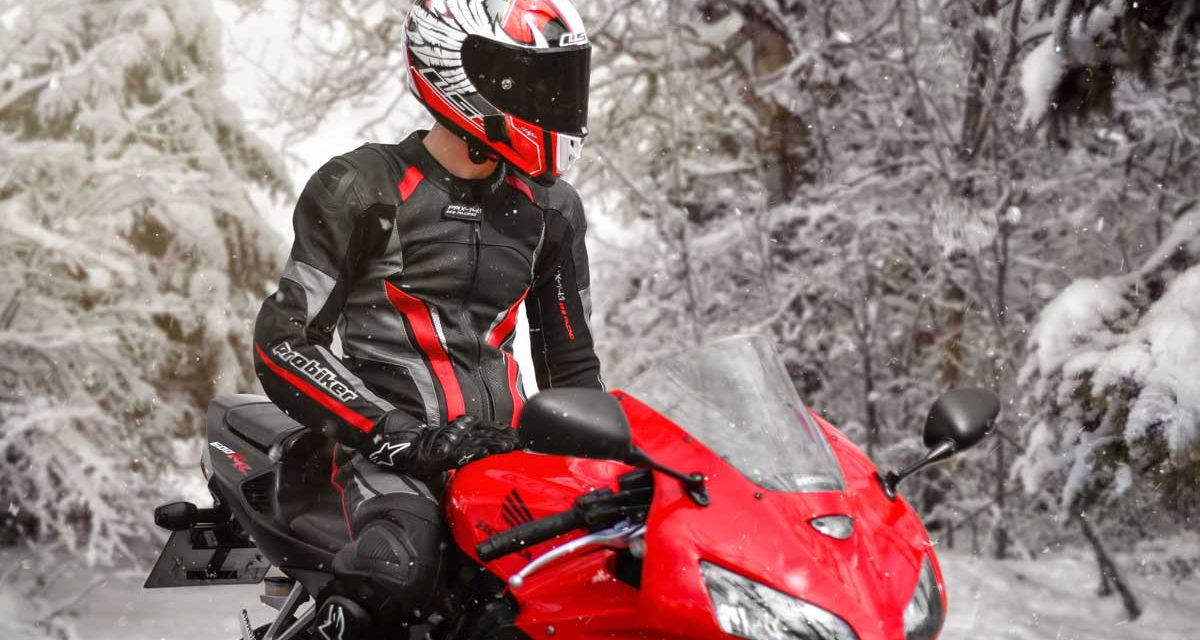The rush of speed in the open air is what draws so many to their motorcycles. It’s an amazing feeling. But one bad cold front or one cross-country trip can turn that open-air freedom into a nuisance, or worse: it can become downright dangerous if you’re not prepared for it. Without the proper gear, discomfort and even hypothermia can become a real issue. When parts of your body start to freeze up, you can get stiff and numb. When your life depends on keeping control of your bike, this can turn an uncomfortable ride into a disaster.
If you want to feel that amazing feeling and also keep all of your earlobes and fingertips, here are some must-have types of winter motorcycle gear arranged just like you are: from top to bottom.
Head
It’s natural to remember that you need a helmet, but when your sweat is freezing over and you’re having trouble concentrating on the road in the biting cold, you’ll wish you had thought of more than just that. A simple fabric helmet-liner can lock in your body heat and take the sting out of the wind.
But remember: your neck is the spot most vulnerable to cold on your entire body. That’s where the wet snow and icy wind can creep in under your jacket and start to give you shivers. A neck warmer can help you protect this vital area, so long as it’s flexible enough to give you the control you need to ride safely.
If you want to combine both the helmet liner and the neck warmer for ultimate dryness on the wet winter roads, a pro-grade Balaclava is the way to go. You want to make sure it’s waterproof and breathable so the cold stays out and the heat your body produces is ventilated to balance with the heat you want to keep locked in. Make sure it goes down to your shoulders and around the collar and sits flat on the seams so your helmet fits over it comfortably. Also make sure it’s made specifically for riding so that it covers most of your mouth, but with the right material to still allow you to breathe comfortably.
Body
Windy cold is worse than standing cold. It creates an effect called “wind chill,” where the heat your body is trying to make is whisked away from you faster and faster, dropping the temperature of your skin and eventually the temperature of your whole body. This is why being prepared for the cold is even more important on the open road than it is on a normal day.
Motorcycle riders need to keep their needs in mind when buying a jacket for the cold winter roads. You need to make sure it’s adjustable – from the cuffs to the shoulders – since you’re probably going to be covered in multiple base layers of clothing (you definitely should be!). You want to check to make sure it’s insulated with thermal lining and/or wind-blocking technology too. You want anything designed specifically to keep the wind out and the heat in. It should come with extra padding at strategic warm spots as well.
Depending on how long you’ll be riding and how cold you think it’s going to be, just a jacket probably isn’t enough. Heated jacket liners are a great way to get the full heat-insulating benefits out of your jacket (and your body). In fact, heated clothes are often considered as essential to winter riding as slowing down and getting the right tires. You want to especially look for something that has concentrated protection in the front to protect against the effects of that awful wind chill.
Hands
When you’re walking around in the cold, your hands can be wherever you want them to be. They’re probably in your pockets, cupped over your hot breath for warmth, or rubbed together for that comfortable friction feeling. But when you’re on a motorcycle, your hands are occupied for long periods of time, facing the hard winds knuckles-first. You may think that your head is more important, but your hands control your life when you’re on a motorcycle. If they stiffen up at the wrong time because of the cold, you could lose crucial control.
Even discounting the winter for a second, any biker should have good gloves. You want to make sure they’re reinforced for grip and padding on the areas that have to scrape over your handles to maintain control. A lot of riding gloves come “pre-curved,” meaning the shape has been altered to more easily allow motorcyclists to leave their hands in the riding position without fighting against the material. Hard knuckles and padded thumbs give you extra protection against the wear and tear of riding.
All of this is even more significant in the winter. Invest in heated gloves to make sure you’re never trying to control your bike with numb fingers. This means you also want to make sure you have a jacket liner you can plug them into (otherwise, you’ll have to buy an extra harness to power them). You can get added protection by investing in a glove liner (heated or not). Make sure everything you put on your hands is made from a stretchable fabric that you have complete control over and doesn’t fight against the riding position of your fingers, causing your hands to stiffen up. That’s the last thing you want.
Legs
Even though your legs aren’t on the handlebars, you still want optimum heat transfer between your body, clothes, and the outside air. You don’t want your legs going numb and stiff or to start shaking in the cold.
If you still want to ride in your normal pants, you can get “overpants,” which pull up over your shoulders like overalls and give your legs total protection, particularly for off-road riding (make sure your pants are big enough at the opening to fit over your boots too). You want to make sure these are snug: otherwise, water from the road can slip into your pant leg and create moist, cold spots that are particularly chilling on long rides.
No matter what overpants you buy, they have to be flexible, but still padded at key points with foam to provide cold and injury protection. Bikers should probably look for anti-scratch fabric too, so it doesn’t get caught on anything while you’re riding.
Whether you invest in overpants or not, a heated inner layer will probably be just as comforting for your legs as it was for your hands. Invest in a heated pant liner that’s flexible enough to let you comfortably move but made with a close enough fit for keeping heat and moisture out.
And if you don’t want to think about jackets and pants at all, a one-piece suit could get you everything you need. Get one that’s insulated for maximum heat retention and wind-blocking but still breathes and flexes. If you have heated gloves or socks, make sure the cuffs of the suit have room for them. Check the room in the leg holes too, where you pull it over your boots.
Feet
The running theme here is that the more areas of your body you keep continuously heated, the more comfortable you’ll be when you’re riding your bike on the winter roads. Your feet are no exception. Not everyone’s shoes are 100% waterproof and that’s how cold spray coming off the roads can become really uncomfortable. If it seeps into your toes at cold enough temperatures and for long enough periods of time, it could even be a hazard.
So even your socks should probably be tailored to suit your winter riding needs. Heated socks that plug into your pants and fit comfortably around your boots can make all the difference. Go for something that isn’t too bulky but has plenty of protection in the toes from the icy wind.
And if you really want a comfortable ride, heated insoles are available to give your whole foot comfortable warmth protection the entire ride. Make sure it contours properly to your feet for the most support and comfort. Some of them even plug into your bike’s battery directly, meaning that you’ll get comfortable heat protection for the entire ride without having to worry about the charge.
Conclusion
Whether it’s a thrill or a necessity, winter motorcycle riding comes with its own risks. The cold wind can cause havoc on your fingers and toes, chill your core, and give you shivers. Any distractions on the open road can be dangerous and having your legs stiffen up or your fingers go numb at the wrong time can be a disaster.
That’s why preparing for the harsh roads requires the right gear. From head to toe, you need to be aware of the most vital spots on your body that need protection and the kind of clothing manufactured specifically to protect those spots, while also giving you the most comfort and flexibility possible. Splurging on heated elements in your suit of clothes might seem indulgent at first, but there’s a reason that regular winter bikers don’t ever go back once they buy them. Nothing beats being warm.



